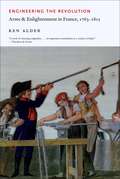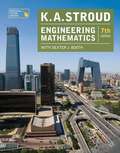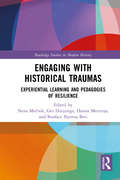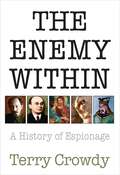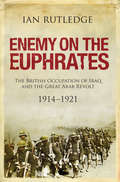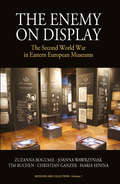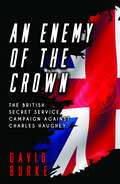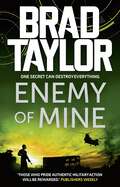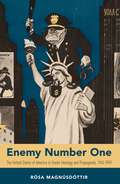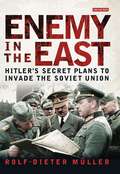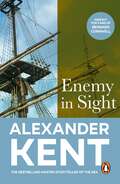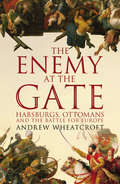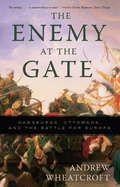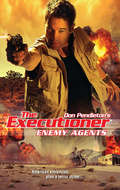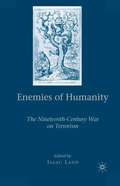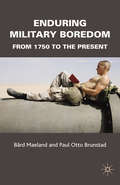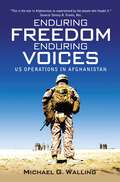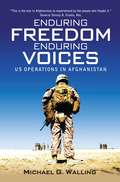- Table View
- List View
Engineering the Revolution: Arms and Enlightenment in France, 1763-1815 (Princeton Legacy Library)
by Ken AlderEngineering the Revolution documents the forging of a new relationship between technology and politics in Revolutionary France, and the inauguration of a distinctively modern form of the “technological life.” Here, Ken Alder rewrites the history of the eighteenth century as the total history of one particular artifact—the gun—by offering a novel and historical account of how material artifacts emerge as the outcome of political struggle. By expanding the “political” to include conflict over material objects, this volume rethinks the nature of engineering rationality, the origins of mass production, the rise of meritocracy, and our interpretation of the Enlightenment and the French Revolution.
Engineering the Revolution: Arms and Enlightenment in France, 1763-1815 (Princeton Legacy Library)
by Ken AlderEngineering the Revolution documents the forging of a new relationship between technology and politics in Revolutionary France, and the inauguration of a distinctively modern form of the “technological life.” Here, Ken Alder rewrites the history of the eighteenth century as the total history of one particular artifact—the gun—by offering a novel and historical account of how material artifacts emerge as the outcome of political struggle. By expanding the “political” to include conflict over material objects, this volume rethinks the nature of engineering rationality, the origins of mass production, the rise of meritocracy, and our interpretation of the Enlightenment and the French Revolution.
Engineering the Revolution: Arms and Enlightenment in France, 1763-1815
by Ken AlderEngineering the Revolution documents the forging of a new relationship between technology and politics in Revolutionary France, and the inauguration of a distinctively modern form of the “technological life.” Here, Ken Alder rewrites the history of the eighteenth century as the total history of one particular artifact—the gun—by offering a novel and historical account of how material artifacts emerge as the outcome of political struggle. By expanding the “political” to include conflict over material objects, this volume rethinks the nature of engineering rationality, the origins of mass production, the rise of meritocracy, and our interpretation of the Enlightenment and the French Revolution.
Engineering the Revolution: Arms and Enlightenment in France, 1763-1815
by Ken AlderEngineering the Revolution documents the forging of a new relationship between technology and politics in Revolutionary France, and the inauguration of a distinctively modern form of the “technological life.” Here, Ken Alder rewrites the history of the eighteenth century as the total history of one particular artifact—the gun—by offering a novel and historical account of how material artifacts emerge as the outcome of political struggle. By expanding the “political” to include conflict over material objects, this volume rethinks the nature of engineering rationality, the origins of mass production, the rise of meritocracy, and our interpretation of the Enlightenment and the French Revolution.
Engineering Mathematics (PDF)
by K. A. StroudEngineering Mathematics is the best-selling introductory mathematics text for students on science and engineering degree and pre-degree courses. Sales of previous editions stand at more than half a million copies. It is suitable for classroom use and self-study. Its unique programmed approach takes students through the mathematics they need in a step-by-step fashion with a wealth of examples and exercises. The book is divided into two sections with the Foundation section starting at Level 0 of the IEng syllabus and the main section extending over all elements of a first year undergraduate course and into many second year courses. The book therefore suits a full range of abilities and levels of access. The Online Personal Tutor guides students through exercises in the same step-by-step fashion as the book, with hundreds of full workings to questions.
Engaging with Historical Traumas: Experiential Learning and Pedagogies of Resilience (Routledge Studies in Modern History)
by Nena Mo 269 Nik Ger Duijzings Hanna Meretoja Bonface Njeresa BetiThis book provides case-studies of how teachers and practitioners have attempted to develop more effective ‘experiential learning’ strategies in order to better equip students for their voluntary engagements in communities, working for sustainable peace and a tolerant society free of discrimination. All chapters revolve around this central theme, testing and trying various paradigms and experimenting with different practices, in a wide range of geographical and historical arenas. They demonstrate the innovative potentials of connecting know-how from different disciplines and combining experiences from various practitioners in this field of shaping historical memory, including non-formal and formal sectors of education, non-governmental workers, professionals from memorial sites and museums, local and global activists, artists, and engaged individuals. In so doing, they address the topic of collective historical traumas in ways that go beyond conventional classroom methods. Interdisciplinary in approach, the book provides a combination of theoretical reflections and concrete pedagogical suggestions that will appeal to educators working across history, sociology, political science, peace education and civil awareness education, as well as memory activists and remembrance practitioners.
Engaging with Historical Traumas: Experiential Learning and Pedagogies of Resilience (Routledge Studies in Modern History)
by Nena MočnikThis book provides case-studies of how teachers and practitioners have attempted to develop more effective ‘experiential learning’ strategies in order to better equip students for their voluntary engagements in communities, working for sustainable peace and a tolerant society free of discrimination. All chapters revolve around this central theme, testing and trying various paradigms and experimenting with different practices, in a wide range of geographical and historical arenas. They demonstrate the innovative potentials of connecting know-how from different disciplines and combining experiences from various practitioners in this field of shaping historical memory, including non-formal and formal sectors of education, non-governmental workers, professionals from memorial sites and museums, local and global activists, artists, and engaged individuals. In so doing, they address the topic of collective historical traumas in ways that go beyond conventional classroom methods. Interdisciplinary in approach, the book provides a combination of theoretical reflections and concrete pedagogical suggestions that will appeal to educators working across history, sociology, political science, peace education and civil awareness education, as well as memory activists and remembrance practitioners.
The Enemy Within: A History of Spies, Spymasters and Espionage
by Terry CrowdySeparating myth from reality, The Enemy Within traces the history of espionage from its development in ancient times through to the end of the Cold War and beyond, shedding light on the clandestine activities that have so often tipped the balance in times of war. This detailed account delves into the murky depths of the realm of spymasters and their spies, revealing many amazing and often bizarre stories along the way. From the monkey hanged as a spy during the Napoleonic wars to the British Double Cross Committee in World War II, this journey through the history of espionage shows us that no two spies are alike and their fascinating stories are fraught with danger and intrigue.
The Enemy Within: A History of Spies, Spymasters and Espionage (General Military Ser.)
by Terry CrowdySeparating myth from reality, The Enemy Within traces the history of espionage from its development in ancient times through to the end of the Cold War and beyond, shedding light on the clandestine activities that have so often tipped the balance in times of war. This detailed account delves into the murky depths of the realm of spymasters and their spies, revealing many amazing and often bizarre stories along the way. From the monkey hanged as a spy during the Napoleonic wars to the British Double Cross Committee in World War II, this journey through the history of espionage shows us that no two spies are alike and their fascinating stories are fraught with danger and intrigue.
Enemy on the Euphrates: The Battle for Iraq, 1914 - 1921
by Ian RutledgeIn 1920 an Arab revolt came perilously close to inflicting a shattering defeat upon the British Empire's forces occupying Iraq after the Great War. A huge peasant army besieged British garrisons and bombarded them with captured artillery. British columns and armoured trains were ambushed and destroyed, and gunboats were captured or sunk. Britain's quest for oil was one of the principal reasons for its continuing occupation of Iraq. However, with around 131,000 Arabs in arms at the height of the conflict, the British were very nearly driven out. Only a massive infusion of Indian troops prevented a humiliating rout.Enemy on the Euphrates is the definitive account of the most serious armed uprising against British rule in the twentieth century. Bringing central players such as Winston Churchill, T. E. Lawrence and Gertrude Bell vividly to life, Ian Rutledge's masterful account is a powerful reminder of how Britain's imperial objectives sowed the seeds of Iraq's tragic history.
The Enemy on Display: The Second World War in Eastern European Museums (Museums and Collections #7)
by Zuzanna Bogumił Joanna Wawrzyniak Tim Buchen Christian GanzerEastern European museums represent traumatic events of World War II, such as the Siege of Leningrad, the Warsaw Uprisings, and the Bombardment of Dresden, in ways that depict the enemy in particular ways. This image results from the interweaving of historical representations, cultural stereotypes and beliefs, political discourses, and the dynamics of exhibition narratives. This book presents a useful methodology for examining museum images and provides a critical analysis of the role historical museums play in the contemporary world. As the catastrophes of World War II still exert an enormous influence on the national identities of Russians, Poles, and Germans, museum exhibits can thus play an important role in this process.
An Enemy of the Crown: The British Secret Service Campaign against Charles Haughey
by David BurkeIn the early 1970s, Sir Maurice Oldfield of the British Secret Service, MI6, embarked upon a decade-long campaign to derail the political career of Charles Haughey. The English spymaster believed Haughey was a Provisional IRA godfather, therefore, a threat to Britain. Oldfield was assisted by unscrupulous British agents and by a shadowy group of conspirators inside the Irish state’s security apparatus, all sharing his distrust of Haughey. Escaping scrutiny for their actions until now, Enemy of the Crown examines more than a dozen instances of their activities. Oldfield was conspiratorial by nature and lacked a moral compass. Involved in regime change plots and torture in the Middle East, in the Republic of Ireland he engaged with convicted criminals as agent provocateurs as well as the exploitation of pedophile rings in Northern Ireland. He and his spies engaged in dirty tricks as they ran vicious smear campaigns in Ireland, Britain and the US. MI6 and IRD intrigues were deployed to impede Haughey's bid to secure a position on Fianna Fáil’s front bench and any return to respectability. London’s hateful drive against Haughey saw no let-up after Fianna Fáil’s triumphal return to power in 1977 which saw them win a large majority of seats in the Dáil. When Haughey sought a place at Cabinet, Oldfield and his spies devised more dirty tricks to impede him. While Haughey was suspicious of MI6 interference, he had no inkling of the full extent of London’s clandestine efforts to destroy him. By circulating lurid stories about him, they played a major part in trying to prevent him succeed Jack Lynch as Taoiseach in 1979. This book attempts to shed light on some of the anti-Haughey conspiracies which took place during the period of the late 1960s right through to the early 1980s.
Enemy of Mine: A gripping military thriller from ex-Special Forces Commander Brad Taylor (Taskforce #3)
by Brad TaylorOne secret can destroy everything. The US brokered an uncertain peace between Israel and Palestine. The American envoy sent to solidify the treaty was almost killed. Now the Taskforce – a highly classified Special Forces unit – devotes every resource to protect the envoy's life. Pike Logan tracks the assassin through the Middle East, but there's a problem closer to home. An American citizen hides a secret that could bring everything down, including Logan and the entire Taskforce. Perfect for fans of Lee Child, James Deegan and David Baldacci. Praise for Brad Taylor: 'It's an excellent read, and I greatly enjoyed it' Nelson DeMille. 'Pike ranks right up there with Jason Bourne, Jack Reacher and Jack Bauer' John Lescroart. 'Logan is a tough, appealing hero you're sure to root for' Joseph Finder. 'Fresh plot, great actions, and Taylor clearly knows what he is writing about' Vince Flynn.
The Enemy of Love
by Annabelle Thorpe1943. Wartime Italy.Casa Maria sits at the heart of the small Umbrian town of Amatino, famous for its food, wine and the di Luca and Capaldi families who run it. But now Italy is consumed by war and everything must change.For talented cook Sophia di Luca, the discovery her father has left the trattoria not to her, but to the volatile and charismatic Giorgio Capaldi, is a bitter disappointment. Still grieving the sudden death of his wife, and in no mood to compromise, Giorgio's return to Amatino threatens everything Sophia has struggled to achieve.As Mussolini falls and the Germans march in, the two families find themselves in conflict not only with a terrifying new enemy, but also with each other.Annabelle Thorpe's gripping novel does for wartime Italy what Victoria Hislop does for Greece.'A joyous read, which really spoke to me about the indomitability of the human spirit. A wonderful book.' Elizabeth Enfield, author of Ivy and AbePraise for Annabelle Thorpe: 'Unputdownable!' Claire Dyer, author of The Last Day 'A pacy, engaging tale of human weakness and of passion so overwhelming it can make fools of us all' Daily Express
Enemy Number One: The United States of America in Soviet Ideology and Propaganda, 1945-1959
by Rósa MagnúsdóttirEnemy Number One tells the story of the Soviet cultural and propaganda apparatus and its efforts to control information about the United States in the postwar landscape. Beginning with the 1945 meeting of American and Soviet troops on the Elbe, this period saw cultural relations develop in close connection to oppression as the Soviet authorities attempted to contain and appropriate images of the United States. Rósa Magnúsdóttir analyzes two official narratives about the USSR's "enemy number one" --Stalin's anti-American campaign and Khrushchev's policy of peaceful coexistence--and shows how each relied on the legacy of the wartime alliance in their approach. Stalin used the wartime experience to spread fear of a renewed war, while Khrushchev used the wartime alliance as proof that the two superpowers could work together. Drawing from extensive archival resources, Magnúsdóttir brings to life the propaganda warriors and ideological chiefs of the early Cold War period in the Soviet Union, revealing their confusion and insecurities as they attempted to navigate the uncertain world of late Stalin and early Khrushchev cultural bureaucracy. She also demonstrates how concerned Soviet authorities were by their people's presumed interest in the United States, resorting to monitoring and even repression-behavior indicative of the inferiority complex of the Soviet project as it related to the outside world.
Enemy in the East: Hitler's Secret Plans to Invade the Soviet Union
by Rolf-Dieter MüllerOperation Barbarossa, Hitler's invasion of the Soviet Union in 1941, led to one of the most brutal campaigns of World War II: of the estimated 70 million people who died in World War II, over 30 million died on the Eastern Front. Although it has previously been argued that the campaign was a pre-emptive strike, in fact, Hitler had been planning a war of intervention against the USSR ever since he came to power in 1933. Using previously unseen sources, acclaimed military historian Rolf-Dieter Müller shows that Hitler and the Wehrmacht had begun to negotiate with Poland and had even considered an alliance with Japan soon after taking power. Despite the signing of the Molotov-Ribbentrop Pact, at the declaration of war in September 1939, military engagement with the Red Army was still a very real and imminent possibility. In this book, Müller takes us behind the scenes of the Wehrmacht High Command, providing a fascinating insight into an unknown story of World War II.
Enemy In Sight: (The Richard Bolitho adventures: 12): an all-action, all-guns-blazing adventure on the high seas from the master storyteller of the sea (Richard Bolitho #12)
by Alexander KentFans of Patrick O'Brian and C. S. Forester will love this engrossing and enthralling naval adventure from multi-million copy seller Alexander Kent. You'll be gripped from page one!'One of our foremost writers of naval fiction' -- Sunday Times'As a former naval officer, Alexander Kent knows what it is like to be at sea' -- The Times'Impossible to put down!' -- ***** Reader review'Plenty of action and intrigue to keep you wanting to read just one more chapter' -- ***** Reader review'As ever, the author keeps you totally involved. A true page turner.' -- ***** Reader review'A jolly good read and difficult to put down' -- ***** Reader review'Outstanding' -- ***** Reader review**************************************************************************************1794: as the year draws to a close Richard Bolitho, commanding the old Hyperion, leaves Plymouth to join a squadron blockading the rising power of Revolutionary France. After six months of repairs his ship is ready to fight again, but her company is mostly raw and untrained.Unfortunately, Bolitho finds himself under a commodore who is no match for the French admiral, Lequiller, whose powerful squadron uses guile and ruthless determination to elude him and vanish into the Atlantic. Hyperion gives chase, the desperate voyage taking them from the Bay of Biscay's squall to the heat of the Caribbean - and for each mile sailed and every battle fought, Bolitho finds himself being forced into the ever more demanding role of strategist and squadron commander.Is he up to the challenge?Bolitho's adventures continue in The Flag Captain.
The Enemy at the Gate: Habsburgs, Ottomans and the Battle for Europe
by Andrew WheatcroftIn 1683, two empires - the Ottoman, based in Constantinople, and the Habsburg dynasty in Vienna - came face to face in the culmination of a 250-year power struggle: the Great Siege of Vienna. Within the city walls the choice of resistance over surrender to the largest army ever assembled by the Turks created an all-or-nothing scenario: every last survivor would be enslaved or ruthlessly slaughtered. The Turks had set their sights on taking Vienna, the city they had long called 'The Golden Apple' since their first siege of the city in 1529. Both sides remained resolute, sustained by hatred of their age-old enemy, certain that their victory would be won by the grace of God.Eastern invaders had always threatened the West: Huns, Mongols, Goths, Visigoths, Vandals and many others. The Western fears of the East were vivid and powerful and, in their new eyes, the Turks always appeared the sole aggressors. Andrew Wheatcroft's extraordinary book shows that this belief is a grievous oversimplification: during the 400 year struggle for domination, the West took the offensive just as often as the East. As modern Turkey seeks to re-orient its relationship with Europe, a new generation of politicians is exploiting the residual fears and tensions between East and West to hamper this change. The Enemy at the Gate provides a timely and masterful account of this most complex and epic of conflicts.
The Enemy at the Gate: Habsburgs, Ottomans, and the Battle for Europe
by Andrew WheatcroftAn acclaimed history of the Great Siege of Vienna, when the Ottoman Empire and the Habsburg dynasty came face to faceIn 1683, an Ottoman army that stretched from horizon to horizon set out to seize Vienna, the bulwark of Christendom. The ensuing siege pitted battle-hardened Janissaries wielding seventeenth-century grenades against Habsburg armies widely feared for their savagery. The walls of Vienna bristled with guns as the besieging Ottoman host launched bombs, fired cannons, and showered the populace with arrows. Each side was sustained by the hatred of its age-old enemy, certain that victory would be won by the grace of God.The Great Siege of Vienna is the centerpiece of historian Andrew Wheatcroft's richly drawn portrait of the complex centuries-long rivalry between the Ottoman and Habsburg empires for control of the European continent. A gripping work by a master historian, The Enemy at the Gate offers a timely examination of an epic clash of civilizations.
Enemy Agents
by Don PendletonWhen California's Mojave Desert becomes the training ground for a homegrown militia group with a deadly scheme to "take back" America, Mack Bolan is sent in to unleash his own form of destruction. But first he'll have to infiltrate the unit and unravel their plot before it's too late.
Enemies To Lovers: Detective Defender / Bulletproof Seal / Danger On Dakota Ridge
by Marilyn Pappano Carol Ericson Cindi MyersToo dangerous to trust?
Enemies of Humanity: The Nineteenth-Century War on Terrorism
by I. LandThis collection of essays offers a fresh perspective on the definition and origins of terrorism, broadening the field to include slave revolts and urban tensions, and considering how the "war on terrorism" had already matured by 1870 as a way to justify often bloody campaigns against labor unions, nationalist freedom fighters, and reformers.
Enduring Military Boredom: From 1750 to the Present
by B. Maeland P. Brunstad Bård MælandIt is often said that war is 5% horror and 95% boredom. In this sense, military boredom is historically enduring as well as personally enduring for the soldiers who have to endure it. This book contributes to a deeper understanding – historically, empirically and theoretically – of the complex phenomenon of boredom in a military context.
Enduring Freedom Enduring Voices: Us Military Operations In Afghanistan
by Michael G. Walling"Michael Walling has honored the American men and women who served in Operation Enduring Freedom by helping them tell their own stories. This is the war in Afghanistan as experienced by the people who fought it.†? General Tommy R. Franks, Ret. The war in Afghanistan has seen men and women thrown into America's longest sustained combat operation. For over 13 years, US military personnel have been embroiled in a conflict unlike any other, in a hostile country where danger and death lurk at every turn. The nature of the fighting has transformed not only the entire structure of the US military, but the lives of every soldier, sailor, marine, coast guardsman, and airman who served there. There have been many tales told of this most recent Afghan war, but until now no single work has combined the strategic view of high-level commanders with the perspective of soldiers on the ground. This book places the first-hand accounts of serving men and women into the context of the military operations. Drawing on gripping oral histories from theater commanders, Special Forces troops, reconstruction teams, and everyday soldiers, Michael G. Walling analyzes operations as they were experienced by individuals, from those immediately following 9/11 through to those in 2014 as US troops prepared to withdraw. He also charts the evolution of US military structure as it was forced to adapt to cope with the non-conventional, but nonetheless deadly threats of asymmetric warfare, as well as detailing covert ops, infrastructure rebuilding, and the training of Afghan forces. Resonating across gender, age, nationality, and ethnicity, this book is not just a document of US fortunes in a far-flung conflict. It is a tribute to the determination, heroism, sacrifice, and the strength of the human spirit.
Enduring Freedom, Enduring Voices: US Operations in Afghanistan
by Michael G. Walling“Michael Walling has honored the American men and women who served in Operation Enduring Freedom by helping them tell their own stories. This is the war in Afghanistan as experienced by the people who fought it.” General Tommy R. Franks, Ret. The war in Afghanistan has seen men and women thrown into America's longest sustained combat operation. For over 13 years, US military personnel have been embroiled in a conflict unlike any other, in a hostile country where danger and death lurk at every turn. The nature of the fighting has transformed not only the entire structure of the US military, but the lives of every soldier, sailor, marine, coast guardsman, and airman who served there. There have been many tales told of this most recent Afghan war, but until now no single work has combined the strategic view of high-level commanders with the perspective of soldiers on the ground. This book places the first-hand accounts of serving men and women into the context of the military operations. Drawing on gripping oral histories from theater commanders, Special Forces troops, reconstruction teams, and everyday soldiers, Michael G. Walling analyzes operations as they were experienced by individuals, from those immediately following 9/11 through to those in 2014 as US troops prepared to withdraw. He also charts the evolution of US military structure as it was forced to adapt to cope with the non-conventional, but nonetheless deadly threats of asymmetric warfare, as well as detailing covert ops, infrastructure rebuilding, and the training of Afghan forces. Resonating across gender, age, nationality, and ethnicity, this book is not just a document of US fortunes in a far-flung conflict. It is a tribute to the determination, heroism, sacrifice, and the strength of the human spirit.
